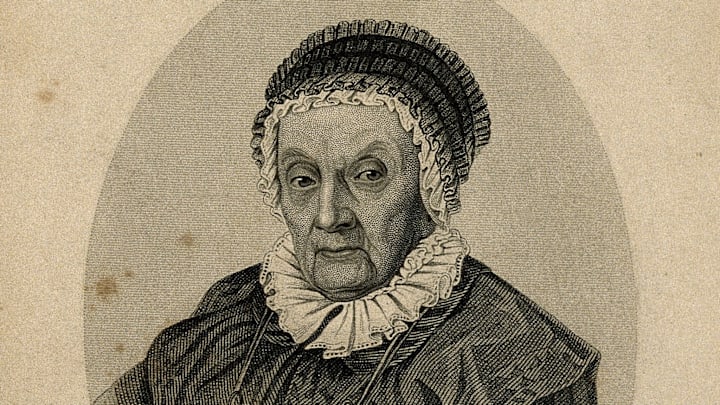Caroline Herschel (1750–1848) was a German astronomer who made major contributions to science—though her work was often overshadowed by her brother's discoveries. Here are eight things you should know about Caroline Herschel and her trailblazing career.
1. Caroline Herschel was the first woman to discover a comet.
Herschel observed her first comet in August 1786. Then, in December 1788, she spotted the comet now called 35P/Herschel-Rigollet. Because its orbital period is 155 years, 35P/Herschel-Rigollet will next be visible to humans on Earth in 2092. Herschel eventually discovered a total of eight comets as well as 14 nebulae.
2. Caroline Herschel initially wanted to be a singer.
In her early 20s, Herschel moved from Hanover, Germany, to England to be a singer. Her brother, William Herschel, was working as a music teacher in the English city of Bath and gave her singing lessons while she helped him keep house. They were both obsessed with the heavens and spent much of their free time making celestial observations. Caroline eventually served as William's assistant, grinding and polishing the mirrors for his telescopes. He discovered Uranus in 1781.
3. Caroline Herschel turned her scientific passion into a paying job.
In England, Herschel became the first female scientist to be paid in a professional capacity when King George III made William his personal astronomer in 1787. William received £200 per year; Caroline received £50 per year to work as his assistant.
4. Caroline Herschel created a massive star catalog.
In 1798, Herschel published an Index to Flamsteed's Observations of the Fixed Stars, containing corrections to the star catalog written by England's former Astronomer Royal, John Flamsteed, and published in 1725. In addition to her updates to Flamsteed's work, she added 560 stars to the catalog.
5. Caroline Herschel's achievements failed to crack the glass ceiling for other female scientists.
Herschel was the first woman to receive the Gold Medal from the Royal Astronomical Society, its highest honor, in 1828. Let it be known, however, that her nephew John Frederick William Herschel received the society's Gold Medal for his astronomical work two years earlier. The second woman to receive one, Vera Rubin, got hers well over 150 years later, in 1996.
6. Caroline Herschel cheated at math (sort of).
Because Caroline was one of 10 Herschel siblings, and often in delicate health, her parents prepared her for a life of domestic housekeeping instead of investing in her education. She didn't receive much formal schooling. Even later in life, when she was calculating astronomical data, she used a cheat sheet of multiplication tables.
7. A crater on Earth's moon honors Caroline Herschel's contributions to astronomy.
A crater on the moon is named C. Herschel in her honor. The small crater is located on the west side of Mare Imbrium, one of the moon's large rocky plains.
8. Caroline Herschel was still winning awards in her 90s.
For her 96th birthday, in 1846, King Frederick William IV awarded Prussia's Gold Medal for Science to Herschel for her astronomical achievements. Two years later, she passed away at age 98.
This article was originally published in 2017; it has been updated for 2022.
